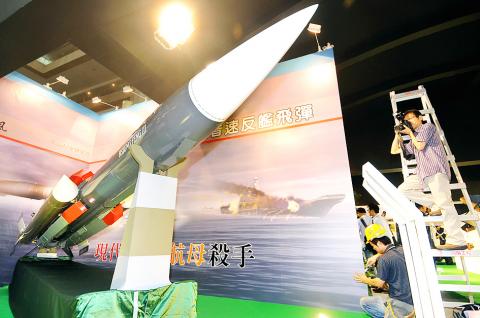Additional deployment of the locally developed Hsiung Feng III (HF-3) “Brave Wind” surface-to-surface supersonic anti-ship missile on LaFayette-class Kang Ding (康定級)and Chi Yang Knox-class(濟陽級) frigates within the year is being considered in the face of China’s increasing buildup of its naval capabilities, the Ministry of National Defense said yesterday.
The HF-3 supersonic surface-to-surface missile had been under research and development by the Chungshan Institute of Science and Technology (中山科學研究院) for nearly two decades, and was made public in a military exercise in 2007.
While the ministry has not released any information on the capabilities of the HF-3 missile, military magazines surmise that the missile may reach speeds of between Mach 2.5 and Mach 3 at a range of between 150km and 200km.

Photo: Taipei Times
The magazines also report that the missile might be equipped with an active radar homing system and would be guided by the navy’s communication and observation systems in a wartime situation, and, as such, the missile could be considered a “fire-and-forget” type of missile.
According to an anonymous source who participated in the Hsiung Feng project, the HF-3 is more precise than either of its predecessors — the Hsiung Feng I and Hsiung Feng II — and is also superior in terms of its ability to penetrate the defensive capabilities of enemy ships.
Commenting on the tight lid the military has kept on the missile’s capabilities and specifications, the source said the difficulty in making supersonic missiles lay not in the principle, but in the missiles’ exterior form and calibrations.
Nations all over the world have classified such information, and Taiwan is no different, the source said.
The source added that the success of the Chungshan Institute in completing the missile was an important milestone for the nation.
The ministry said that the missile has already been deployed on the Cheng Kung-class(成功級) frigate, the navy’s Perry-class frigates, the locally researched and made Ching Chiang class(錦江級), and the Kuang Hua VI-class fast attack missile craft (光華六號).
The ministry is also considering deploying the HF-3 missiles on the two Oliver Hazard Perry-class frigates that the ministry intends to purchase from the US next year, ministry officials said.
Meanwhile, the ministry has professed concern that China also appears interested in researching supersonic surface-to-surface missiles, adding that the success of such a venture was extremely important to the military balance in the Taiwan Strait.

AIR SUPPORT: The Ministry of National Defense thanked the US for the delivery, adding that it was an indicator of the White House’s commitment to the Taiwan Relations Act Deputy Minister of National Defense Po Horng-huei (柏鴻輝) and Representative to the US Alexander Yui on Friday attended a delivery ceremony for the first of Taiwan’s long-awaited 66 F-16C/D Block 70 jets at a Lockheed Martin Corp factory in Greenville, South Carolina. “We are so proud to be the global home of the F-16 and to support Taiwan’s air defense capabilities,” US Representative William Timmons wrote on X, alongside a photograph of Taiwanese and US officials at the event. The F-16C/D Block 70 jets Taiwan ordered have the same capabilities as aircraft that had been upgraded to F-16Vs. The batch of Lockheed Martin

GRIDLOCK: The National Fire Agency’s Special Search and Rescue team is on standby to travel to the countries to help out with the rescue effort A powerful earthquake rocked Myanmar and neighboring Thailand yesterday, killing at least three people in Bangkok and burying dozens when a high-rise building under construction collapsed. Footage shared on social media from Myanmar’s second-largest city showed widespread destruction, raising fears that many were trapped under the rubble or killed. The magnitude 7.7 earthquake, with an epicenter near Mandalay in Myanmar, struck at midday and was followed by a strong magnitude 6.4 aftershock. The extent of death, injury and destruction — especially in Myanmar, which is embroiled in a civil war and where information is tightly controlled at the best of times —

China's military today said it began joint army, navy and rocket force exercises around Taiwan to "serve as a stern warning and powerful deterrent against Taiwanese independence," calling President William Lai (賴清德) a "parasite." The exercises come after Lai called Beijing a "foreign hostile force" last month. More than 10 Chinese military ships approached close to Taiwan's 24 nautical mile (44.4km) contiguous zone this morning and Taiwan sent its own warships to respond, two senior Taiwanese officials said. Taiwan has not yet detected any live fire by the Chinese military so far, one of the officials said. The drills took place after US Secretary

THUGGISH BEHAVIOR: Encouraging people to report independence supporters is another intimidation tactic that threatens cross-strait peace, the state department said China setting up an online system for reporting “Taiwanese independence” advocates is an “irresponsible and reprehensible” act, a US government spokesperson said on Friday. “China’s call for private individuals to report on alleged ‘persecution or suppression’ by supposed ‘Taiwan independence henchmen and accomplices’ is irresponsible and reprehensible,” an unnamed US Department of State spokesperson told the Central News Agency in an e-mail. The move is part of Beijing’s “intimidation campaign” against Taiwan and its supporters, and is “threatening free speech around the world, destabilizing the Indo-Pacific region, and deliberately eroding the cross-strait status quo,” the spokesperson said. The Chinese Communist Party’s “threats